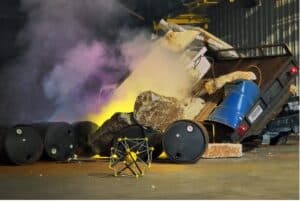
Squishy Robotics has collaborated with major fire departments and aims to develop mobile models of its robots in addition to its current stationary ones.
Spherical robots funded by the NASA Early Stage Innovations (ESI) group that could explore planetary and lunar surface are finding terrestrial uses.
The robots are the work of Squishy Robotics, which has developed impact-resistant spherical robots using the principle of tensegrity. The term is short for tensile (or tensional) integrity and was coined by R. Buckminster Fuller. His geodesic domes are tensegrity structures.
These robots are designed to distribute impact across their skeletal structure. They can be air-deployed into hazardous environments or areas with rough terrain.
See also: AI Used to Prevent Californian Wildfires
Hazardous conditions in space, hazardous conditions on earth
With the ability to customize the robots with various sensors, they can provide crucial real-time data to first responders during disaster response situations, such as assessing dangers like toxic gas leaks or aiding in wildfire detection. The founder of Squishy Robotics, Dr. Alice Agogino, as noted, originally researched spherical, skeletal robots for space exploration but soon recognized that the technology could also benefit terrestrial applications, particularly in disaster response.
The robots, resembling ball-shaped skeletons made of rods and elastic cables, utilize the tensegrity principle to dissipate impact forces. This structural design enables the unit to withstand drops and collapse into compact packages for transportation.
See also: Robot Drones Take Flight, Looking Down For Real-Time Data
NASA remains committed to robots research for both space and terrestrial pursuits
The technology developed by Squishy Robotics highlights NASA’s continued commitment to transferring technology to the private sector. NASA provided funding to Agogino and her team at the University of California, Berkeley, to study the mobility of tensegrity robots using gas thrusters. These grants aim to accelerate the development of innovative space technologies with significant potential.
The tensegrity robots designed by Agogino and her team were designed for missions on other planets, where they could be dropped from spacecraft, survive the impact, and traverse challenging terrains. In early tests, Squishy Robotics has integrated miniaturized chemical gas sensors into their robots, allowing them to be deployed by aircraft to gather readings before firefighters enter hazardous areas. The data collected by these units can help inform decisions regarding the use of protective gear and reduce response times.
Squishy Robotics has collaborated with major fire departments and established reseller agreements with distributors. The company is continuously improving its offering, aiming to develop mobile models in addition to its current stationary ones.



























